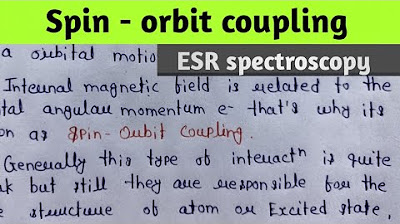8.12. Using Tanabe Sugano Diagrams
Summary
TLDRThis video discusses the interpretation of absorption spectra using Tanabe-Sugano diagrams, focusing on the transitions in d-orbital complexes. The lecturer explains the concepts of spin-allowed vs spin-forbidden and Laporte-forbidden transitions, providing examples of high-spin and low-spin complexes. Emphasis is placed on the role of ligand field strength, with references to the spectrochemical series and charge transfer transitions. The video also covers practical tips for analyzing absorption spectra, especially for octahedral complexes, and offers advice for tackling related homework problems using Tanabe-Sugano diagrams for quantitative analysis.
Takeaways
- 😀 Spin and Laporte selection rules are essential in determining whether transitions are allowed or forbidden in absorption spectra.
- 😀 d to d transitions are typically Laporte forbidden due to the symmetry of the orbitals, making them weak.
- 😀 Tetrahedral complexes are always spin-allowed, as they lack inversion symmetry and can't be Laporte forbidden.
- 😀 Ligand-to-metal and metal-to-ligand charge transfers are examples of allowed transitions, often resulting in intense and high-energy peaks.
- 😀 High spin and low spin configurations can be distinguished by analyzing the Tanabe-Sugano diagram and comparing to the UV-Vis absorption spectrum.
- 😀 The spectrochemical series helps predict whether a transition metal complex will be high or low spin based on the ligand field strength.
- 😀 Cobalt(II) complexes, with a d7 electron configuration and weak field ligands like water, are generally high spin, leading to a quartet ground state.
- 😀 The Tanabe-Sugano diagram for d7 complexes shows different allowed transitions with varying energies, contributing to multiple absorption peaks.
- 😀 A high-energy transition, often seen in the UV range, may indicate a metal-to-ligand or ligand-to-metal charge transfer.
- 😀 To analyze the absorption spectrum, one can compare the energy ratios between peaks and match them to values on the Tanabe-Sugano diagram to deduce the complex's characteristics.
Q & A
What is the primary focus of the video script?
-The video script focuses on practicing the interpretation of absorption spectra using Tanabe-Sugano diagrams, with emphasis on spin and Laporte rules for various transition metal complexes.
What is the significance of the Tanabe-Sugano diagram in the context of absorption spectra?
-The Tanabe-Sugano diagram is a tool used to predict and analyze the electronic energy levels and transitions of transition metal complexes, specifically for d-electron systems, helping to interpret absorption spectra.
What are 'spin allowed' and 'Laporte forbidden' transitions in the context of the script?
-Spin allowed transitions occur when the spin state of the system remains unchanged (e.g., from a quartet to a quartet), while Laporte forbidden transitions occur in complexes with symmetric orbitals (like d-d transitions in octahedral complexes), which are not allowed due to symmetry considerations.
How does the symmetry of tetrahedral complexes affect their electronic transitions?
-Tetrahedral complexes have no inversion symmetry, so their transitions are not Laporte forbidden. If the transition is spin allowed, it becomes fully allowed, making the transition possible.
What are ligand-to-metal and metal-to-ligand charge transfer transitions?
-These transitions involve the excitation of an electron from a metal-centered orbital to a ligand-centered orbital (metal-to-ligand), or from a ligand-centered orbital to a metal-centered orbital (ligand-to-metal), both of which are Laporte allowed and typically exhibit high intensity.
How does the script suggest determining whether a transition is high spin or low spin?
-The script suggests using the spectrochemical series and knowledge of the ligand field to determine spin states. For first-row transition metals with weak field ligands, such as water, the system is likely to be high spin, while for second and third-row transition metals, it’s usually low spin.
Why does the script assume the cobalt(II) complex is high spin?
-The script assumes the cobalt(II) complex is high spin based on the spectrochemical series, which indicates that weak field ligands like water typically lead to high spin states for first-row transition metals.
What is the role of the Tanabe-Sugano diagram in determining the transitions of the d7 octahedral complex?
-The Tanabe-Sugano diagram helps determine the possible electronic transitions in the d7 octahedral complex by analyzing the spin allowed transitions and predicting their energies based on the ligand field strength and spin state.
What kind of transitions contribute to the high-energy peaks in the absorption spectrum?
-High-energy peaks are typically associated with metal-to-ligand or ligand-to-metal charge transfer transitions, which are Laporte allowed and occur at high intensity and energy compared to d-d transitions.
What advice is given for interpreting the Tanabe-Sugano diagram quantitatively for homework?
-The script advises using a ruler to measure the energy differences between peaks in the spectrum, calculating energy ratios, and comparing them with the Tanabe-Sugano diagram to determine the ligand field strength and make further predictions about the system.
Outlines

This section is available to paid users only. Please upgrade to access this part.
Upgrade NowMindmap

This section is available to paid users only. Please upgrade to access this part.
Upgrade NowKeywords

This section is available to paid users only. Please upgrade to access this part.
Upgrade NowHighlights

This section is available to paid users only. Please upgrade to access this part.
Upgrade NowTranscripts

This section is available to paid users only. Please upgrade to access this part.
Upgrade NowBrowse More Related Video

481 - 17 Using Tanabe Sugano

Ligand Field Theory and the Jahn-Teller Effect

Spin-orbit coupling|| Spin-orbit intraction ||fine structure of - H atom|| #spin orbit coupling...

Espectrometria de absorção molecular - Parte 1: Fundamentos

Bohr Model of the Hydrogen Atom

3.3.3 - Radiação eletromagnética: Teoria Quântica - Emissão de luz por gases excitados (Bohr)
5.0 / 5 (0 votes)